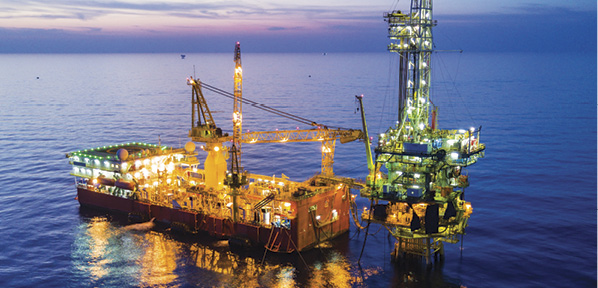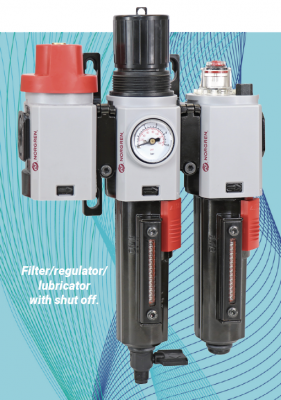Oil Cleanliness in Wind Turbine Hydraulic Pitch Systems
By Justin Stover, Wind Segment Manager, C.C. Jensen
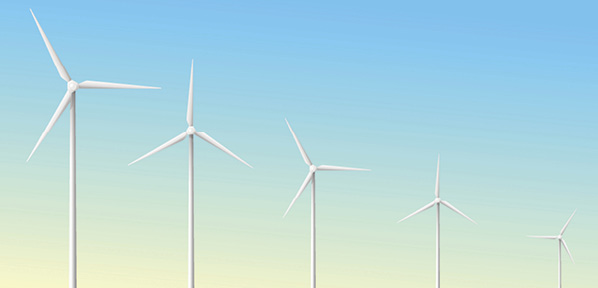
In the wind turbine industry, a revolution is happening within oil maintenance. Changing oil used to be based on time and operation hours, but many wind turbine owners see this method as obsolete. Studies have shown that too much oil and many hydraulic components have been prematurely replaced simply because of contamination in the oil. A new and improved way of triggering an oil change is looking at the condition of the fluid and taking steps to ensure oil cleanliness. The benefit is longer oil service life, often 3 times longer depending on environment and filtration level. Furthermore, maintaining fluid cleanliness will increase the service life of hydraulic components.
Hydraulic pitch systems are the muscle that controls wind-turbine blades. There are two types of control used in wind energy, either an electric or hydraulic device for many turbines rated at or below 2.5 MW. However, the job of pitching blades for turbines over 3 MW often belongs to hydraulics. Larger turbines require blades that pitch so they are mounted on bearings. It requires a hydraulic power unit in order to drive each blade to its optimum pitch position. The pump and motor are typically mounted with the power unit in the nacelle. The hydraulic pistons are mounted in the hub. A hydraulic rotary joint permits hydraulic fluid to flow from the stationary side to the rotating side. The hydraulic pitch system then controls the pitch of the blades to maintain continuous rotational speed at the generator.
Apart from wind velocity changes, the pitch of the blades can also vary even during a 360-degree rotation of a single blade. Precision control is necessary because wind velocity at the 12 o’clock position may be significantly different from its velocity at the 6 o’clock position. The pitch of each blade varies continuously and independently. Therefore, proportional valves are a critical component in the hydraulic pitch system.
The oil in this application not only transmits power, but it also provides lubrication, heat transfer, and transports contaminants to be filtered out. It is the lifeblood of the system and so it should be maintained as clean as possible.
Why Is Oil Changed In the First Place?
Not so long ago, a common answer to this question could be: “The oil was dirty, so I replaced it.” However, this is an expensive mindset, since effective filtration can remove solid particles and water quite easily. This is especially important for oil systems that are difficult to access, which includes most land-based wind turbines and offshore wind turbines. Most oil in service will only need to be replaced when the oil is degraded and the properties are no longer intact.
Base Oil and Additives
Lubricating and hydraulic fluids consists of base oil plus 2% to 15% additives. Typical additives are antioxidants, anti-wear, anti-foam, corrosion inhibitors, and for gear oil, also viscosity index improvers, EP additives, and sometimes pour-point depressants. Hydraulic oil is one of the oil types with the least amount of additives. Engine lube oil will, in comparison, often contain 20 – 30% additives. The base oil degrades due to heat, air, water, and metal catalysts such as iron and copper. To fight premature oil degradation, robust base oil is used together with antioxidants (often ZDDP — Zinc Dialkyl Dithio Phosphates).
ZDDP doubles as a polar, metal wetting anti-wear additive (AW), which forms an ash-like film to protect against adhesive wear (metal-to-metal contact) between components in the oil system, e.g., pumps, gears, valves, etc.
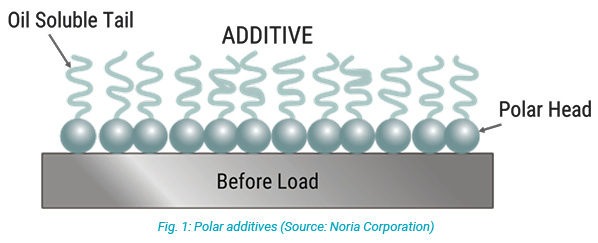
However, polar additives as catalysts will degrade with water and heat and will deplete with excess amounts of particles in the oil. This is one of the reasons why the level of water and particles has to be monitored in oil.
Oil Analysis – New Oil As Baseline
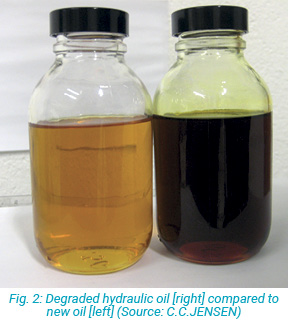 Oil analyses can be used to check remaining oil life by looking at the base oil and additive package. As a rule of thumb, the additive level in used oil has to be minimum 70% of the additive level in new oil. It is therefore vital to sample every incoming oil drum or tote to establish the baseline. This will also help to prevent a faulty oil batch from being used.
Oil analyses can be used to check remaining oil life by looking at the base oil and additive package. As a rule of thumb, the additive level in used oil has to be minimum 70% of the additive level in new oil. It is therefore vital to sample every incoming oil drum or tote to establish the baseline. This will also help to prevent a faulty oil batch from being used.
A Good Oil Analysis Report Should Give Information About The Following:
- The oil suitable for further use: Are base oil properties and additives still intact?
- The condition of the machine: Has a critical wear situation developed?
- The level of contaminants: Are seals, breathers, and filters operating effectively?
- The oil degradation speeding up: Could a severe varnish problem be occurring soon?
Condition-Based Oil Changes
As mentioned earlier, replacing oil based on time or operation hours is expensive and unnecessary. Condition-based oil changes are the optimum way. If you want to trigger oil changes based on the lubricant health, the following five are the primary modes of measure:
Viscosity, AN, FTIR, Elemental Analysis (wear and additive level), and Water by Karl Fisher.
Oil samples need to be taken and analyzed on a regular basis, and it is important to compare the result with the baseline (new oil) and the historic trend. This means only one oil analysis per year would require a very long period to establish a trend.
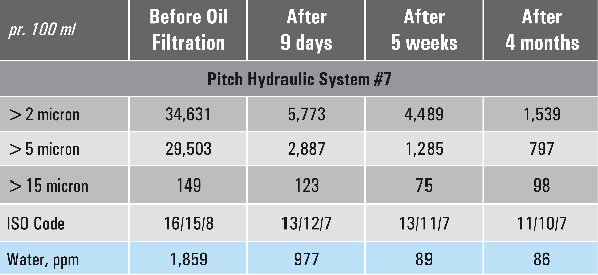
The Following Routine Oil Analyses Should Be Performed On The Wind Turbines (6 Month/Every Service Visit)
- Viscosity and viscosity index (+/- 10% is acceptable. Increase in viscosity can indicate oil degradation.)
- AN (Increase in acidity indicates base oil degradation. 0.5 mgKOH/g above new oil AN is caution level.)
- FTIR (The oil’s “fingerprint” will show oil degradation, water, mix with other fluid types, etc.)
- Elemental Analysis (Will show dirt ingress, wear metals, and additive level)
- Water by Karl Fisher (Very accurate determination of moisture level in oil)
- Particle count according to ISO 4406 (Hard particles from dirt and wear)
Additional Recommended Oil Analyses
- Water release properties (Demulsibility test according to DIN 51599, ISO 6614 or ASTM D1401)
- Foaming tendency and air entrainment tests (According to ISO 6247 or ASTM D892)
- Ferrous density — relation between large/small magnetic particles (DRF, WPC or PQ-index)
- Oil degradation and varnish test (MPC – Membrane Patch Colorimetric, Voltametry/RULER test)
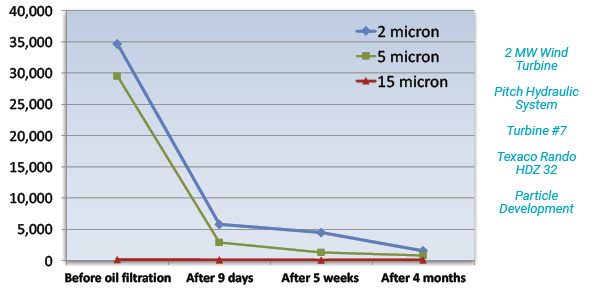
Offline Filter Case Study
A wind turbine owner was experiencing increased particle and water contamination in the pitch hydraulic systems of their 2 MW wind turbines. Based upon the oil analysis, a decision needed to be made to replace the oil at great cost or leave it in service. Obviously continuing to use the dirty oil would put sensitive components, such as proportional valves and cylinders, at a greater risk of premature failure and even more cost. After further consultation, the owner opted to address the oil contamination by adding a so-called offline filter or kidney-loop filter. This offline filter provided a depth type of media that would not only remove solids, but also moisture and soft particles in a compact and economical design. After only 1 month of operation, the following oil cleanliness was achieved using the offline filter:
Particles: The contamination level in the oil was reduced by 95% from 34,631 to 1,539 of 2 µm particles per 100 ml.
Water: The water level was reduced from 1,859 ppm to 86 ppm.
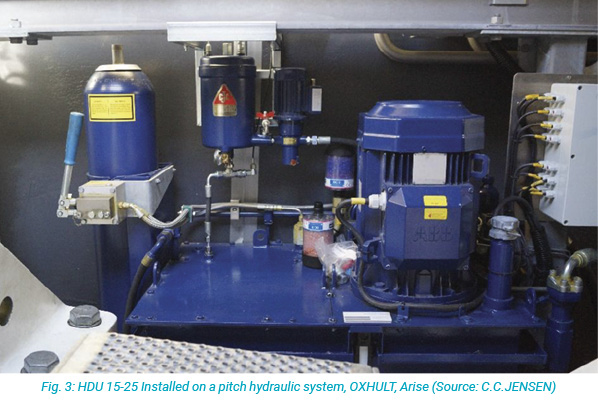
Conclusion
Monitoring oil cleanliness in hydraulic pitch systems can help prevent premature failures and needlessly changing oil. Replacing oil based on oil analyses is the optimum way both for the machine and your economy. A good oil analysis laboratory can interpret the data and indicate whether the oil is suitable for further use. Each result will need to be compared to the baseline and the historic trend, since a stand-alone result doesn’t give much information.
Oil analysis provides the most value if a person is assigned to collect all the oil analysis reports, understand them, and take action. A log book including levels for the baseline, caution, and critical levels is a great tool.
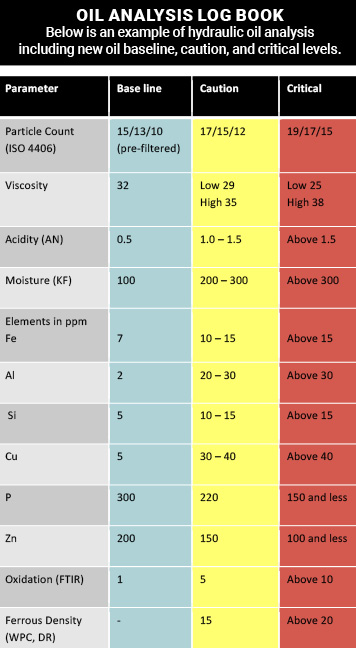
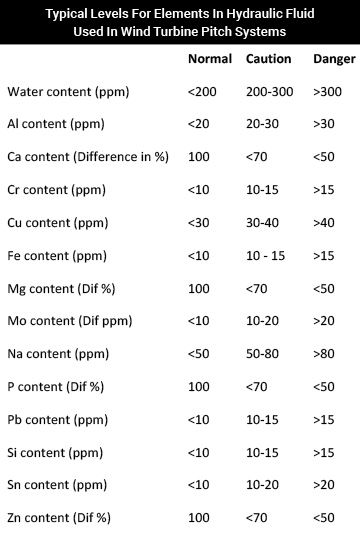
Justin Stover has a CLS, MLA II and AAA in Fluid Power Technology, and more than 18 years of experience working in the Wind Energy Industry.



